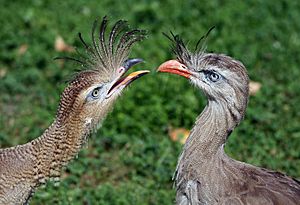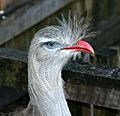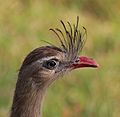Red-legged seriema facts for kids
The red-legged seriema (Cariama cristata) is a large bird that mostly lives on the ground. It's known for hunting small animals. You might also hear it called the crested seriema because of the feathers on its head. This bird belongs to the seriema family, called Cariamidae.
Red-legged seriemas live in many parts of South America. You can find them in central and eastern Brazil, eastern Bolivia, Paraguay, Uruguay, and central Argentina.
Just like its cousin, the black-legged seriema, farmers sometimes use these birds to protect their chickens and other farm animals from predators. They can even scare away human intruders!
Quick facts for kids Red-legged seriema |
|
|---|---|
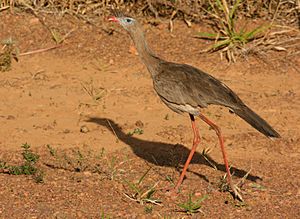 |
|
| Near Goiânia in central Brazil | |
| Conservation status | |
| Scientific classification | |
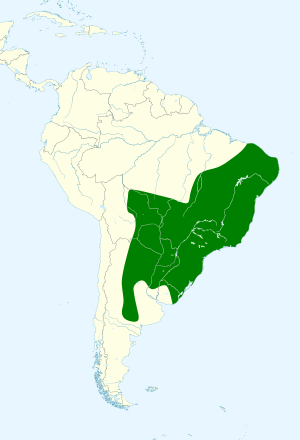 |
|
| Synonyms | |
|
(Genus)
(Species)
|
Contents
What's in a Name?
The red-legged seriema was first described in 1766 by a Swedish scientist named Carl Linnaeus. He gave it the scientific name Palamedea cristata. Today, it's the only species in the group called Cariama. This group was named by a French zoologist, Mathurin Jacques Brisson, in 1760.
The word cristata comes from Latin and means "crested" or "tufted," which describes the bird's unique head feathers. The name "Cariama" itself comes from an old Tupi word, çariama, which means "raised crest."
Appearance and Features
The red-legged seriema is a tall bird, usually about 75 to 90 centimeters (30 to 35 inches) long. It weighs around 1.5 to 2.2 kilograms (3.3 to 4.8 pounds). Males are a little bigger than females.
These birds have long legs, long necks, and long tails. Their feathers are mostly grayish-brown with dark brown and black patterns. Their head, neck, and chest are pale brown, and their belly is white. The long tail feathers have a black band and a white tip.
One of their most striking features is their reddish beak and very long, salmon-colored legs. They have bright yellow eyes. Soft feathers grow from the base of their beak, forming a cool fan-shaped crest on their head.
Where They Live
Red-legged seriemas live across a wide area. They are found in central and eastern Brazil, Paraguay, eastern and southeastern Bolivia, Uruguay, and northeastern Argentina. They can live in places as high as 2,000 meters (6,600 feet) above sea level.
These birds love grasslands more than any other place. They enjoy lush meadows near rivers but usually avoid wetlands or farm fields. They prefer dry, open areas like thorny bushes, dry woodlands, savannas, and ranchlands. They are very common in areas like the Caatinga, Cerrado, and Chaco regions.
Daily Life and Habits
Seriemas are cautious birds that protect their territory. They are active during the day and usually stay in one area. You'll often see them alone or in pairs, but sometimes in small family groups of up to four birds.
They mostly walk on the ground and can run very fast. In their natural home, they can easily outrun a human. They might run away from a car at speeds up to 25 kilometers per hour (15 mph) before they decide to fly.
When two seriemas fight over territory, they might sing loudly at each other. Then they might run and fly towards the intruder, sometimes attacking with their claws and beaks. They have even been seen jumping at each other feet-first, flapping their wings to keep balance.
These birds usually build their nests on low trees or bushes. This allows the adult birds to reach the nest by hopping or fluttering from the ground instead of flying.
Their Unique Song
Red-legged seriemas sing loudly, mostly at dawn and sometimes at dusk. Their song can be heard several kilometers away! People describe their song as a mix between "the bark of a young dog and the clucking of turkeys."
When they sing their loudest, the bird bends its neck so its head touches its back. Both parents and even young chicks (as young as two weeks old) will sing. Often, one bird in a family will start singing just as another finishes, or two will sing at the same time.
Their full song has three parts:
- It starts with single notes that repeat at the same pitch but get faster.
- Then, it moves to two or three notes that repeat at a slightly higher pitch and also get faster.
- Finally, it has phrases with up to 10 notes. Shorter notes rise in pitch, and longer ones fall. The number of notes and speed change throughout this part.
What They Eat
Red-legged seriemas eat a variety of foods, depending on what's available. They are omnivores, meaning they eat both plants and animals. Their diet mainly includes:
- Insects and spiders: Like grasshoppers, beetles, ants, and spiders.
- Small animals: Such as lizards, frogs, snakes, and rodents.
- Plants: Sometimes they eat corn, other crops, wild fruits, and tree gum.
In zoos, and likely in the wild, they also eat the eggs and chicks of other birds.
They usually look for food alone or in pairs, walking steadily and searching on the ground or in low plants. Their patterned feathers help them blend in with their surroundings. When they catch a small animal, they grab it with their beak and hit it against the ground. Then they use their beak and claws to break it apart.
Scientists have observed that seriema nests rarely have three young birds grow up. They think that the third chick might sometimes become food for the other two if food is scarce.
Reproduction and Life Cycle
Red-legged seriemas stay with one partner for life. In the wild, they usually breed during the rainy months. This is from February to July in northeast Brazil, September to January in central Brazil, and November to December in Argentina.
During breeding season, the male tries to impress the female. He spreads his wings out wide, showing off the patterns on his flight feathers. This looks a bit like how some birds of prey, like the African secretarybird, display themselves. After this display, he might strut in front of the female with his head pointing up and his crest lifted. The male also brings food to the female. Both birds call out, which helps strengthen their bond and mark their territory.
Typically, a female seriema lays 2 to 3 white eggs with soft spots. Both parents take turns sitting on the eggs, which hatch in 24 to 30 days. The chicks are born with long, light brown feathers. Both parents feed them. When they are born, they weigh about 40 to 60 grams (1.4 to 2.1 ounces).
At around 14 days old, the chicks are strong enough to leave their nest. At this age, they can make a soft call, similar to the adult song, to get their parents' attention. They get their full adult feathers when they are about 4 to 5 months old.
Images for kids
-
Screaming Cariama cristata at Parque das Aves (Foz do Iguaçu)
See also
 In Spanish: Seriema de patas rojas para niños
In Spanish: Seriema de patas rojas para niños



